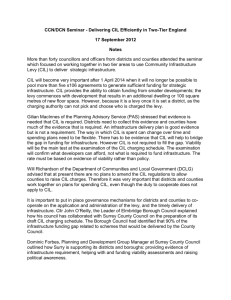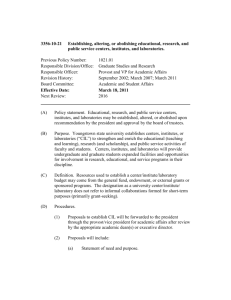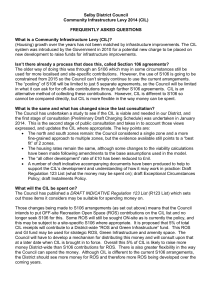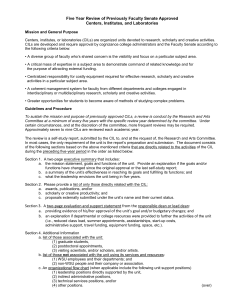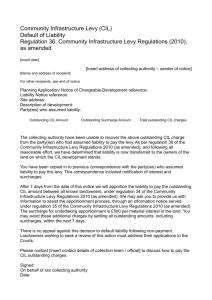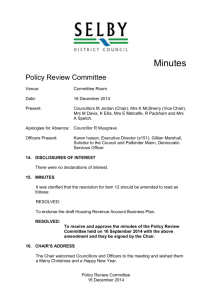February 2015 - Torbay Council
advertisement
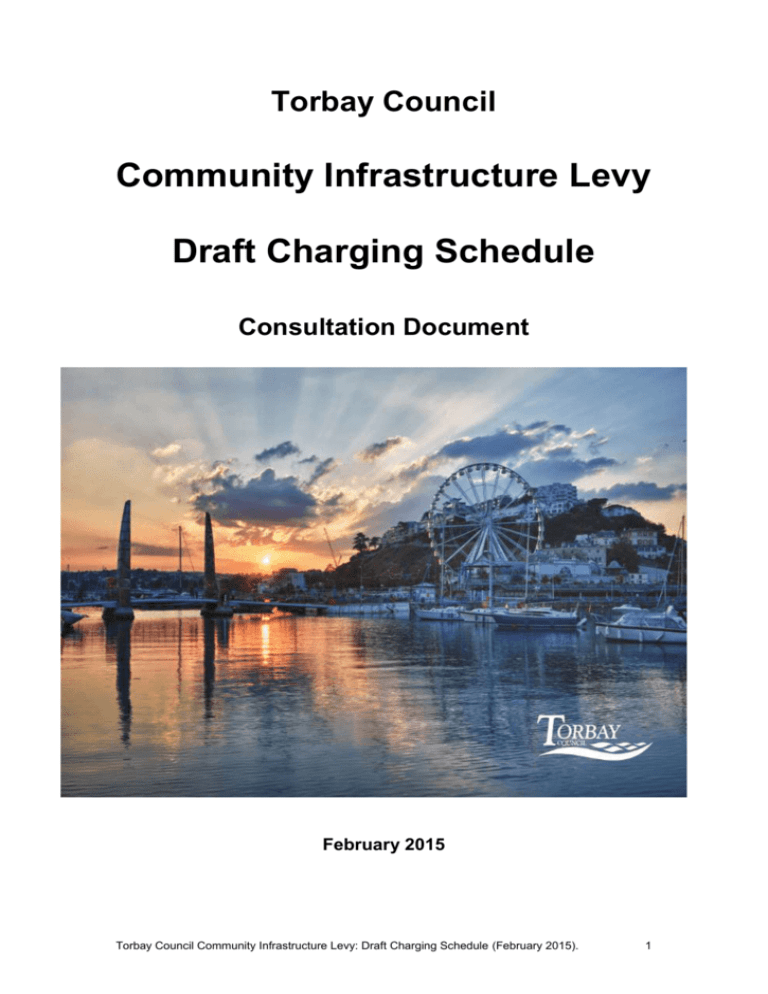
Torbay Council Community Infrastructure Levy Draft Charging Schedule Consultation Document February 2015 Torbay Council Community Infrastructure Levy: Draft Charging Schedule (February 2015). 1 Community Infrastructure Levy Draft Charging Schedule Consultation Document Contents 1. Introduction and Background 2. Next steps 3. Where to find out more 4. The Torbay Infrastructure Delivery Study 5. The CIL and the new Torbay Local Plan – A landscape for success. 6. Who Pays CIL? 7. Torbay’s Proposed Approach to CIL Figure 1: Draft Charging Schedule and relationship to S106 Obligations: Residential Development. Figure 2: Draft Charging Schedule and relationship to S106 Obligations: Commercial and Non-Residential Development. CIL Charging Zones. 8. CIL and S106 Developer Contributions Policy 9. Smaller residential developments and S106 Obligations 10. Larger residential developments and S106 Obligations 11. Social housing 12. Non residential development 13. Calculating the chargeable amount of CIL 14. “Assumed Liability” and Commencement Notices 15. Instalments Policy 16. Exceptional Relief Policy 17. State Aid 18 Draft “Regulation 123” List of Key Infrastructure projects proposed to receive CIL Torbay Council Community Infrastructure Levy: Draft Charging Schedule (February 2015). 2 Torbay Community Infrastructure Levy Draft Charging Schedule 1. Introduction and Background. This is Torbay’s Draft Charging Schedule for the Community Infrastructure Levy (CIL). It follows the Preliminary Draft Charging Schedule consultation that took place between December 2011 and February 2012. Community Infrastructure Levy is a tax levied on development of more than 100 sq m of floor space, or new-build dwellings. It is intended to help fund the infrastructure needed to support growth in Torbay. It is regulated by the Community Infrastructure Levy Regulations 2010 (as amended). The Council is intending to charge CIL on greenfield residential developments of up to 11 dwellings (6 within the Area of Outstanding Natural Beauty), brownfield residential developments of 15 or more dwellings, and out of town/district centre retail developments. Larger residential schemes will not be charged CIL. However, the Council will continue to negotiate S106 Obligations to cover the infrastructure needed to support their development as well as affordable housing. Comments on this Draft Charging Schedule are invited by 9 am on Monday 23rd March 2015. In preference they should be emailed to strategic.planning@torbay.gov.uk or sent by post to Spatial Planning, Torbay Council, Floor 2 Electric House, Castle Circus, Torquay, TQ1 3DR 2. Next Steps Comments received, as a result of this consultation, will be taken into account in preparing a Submission Charging Schedule. This will be submitted to, and considered by, an Independent Examiner (such as the Planning Inspectorate). He or she may approve it, reject it or approve it with modifications. Following receipt of the Examiner’s Report, CIL needs to be adopted by Torbay Council. 3. Where to Find Out More More detailed advice on CIL and the relevant Regulations (with amendments) can be found on the Planning Advisory Service website: http://www.pas.gov.uk/community-infrastructure-levy The government’s online Planning Practice Guidance, Part 25 contains detailed advice on CIL and links to relevant Regulations: http://planningguidance.planningportal.gov.uk/blog/guidance/communityinfrastructure-levy/ Other details about CIL can be found on the Planning Portal’s CIL page: http://www.planningportal.gov.uk/planning/applications/howtoapply/whattosubmit/cil Torbay Council Community Infrastructure Levy: Draft Charging Schedule (February 2015). 3 4. The Torbay Infrastructure Delivery Study Under the CIL Regulations (2010 as amended - most recently in 2014, with further amendments forthcoming), Charging Authorities are required to publish a charging schedule of CIL rates and to identify items of infrastructure they wish to fund through CIL. Charging Authorities should assess the impact of CIL on viability and set it at a level that will not jeopardise development. Charging Authorities are required to strike an appropriate balance between the potential effects of CIL upon development viability and raising funds for infrastructure. Torbay Council is the Charging Authority for the Torbay Local Plan area. Detailed information on the need for infrastructure, estimated funding gaps, and the assessment of viability are contained in the Torbay Infrastructure Delivery Study (Baker Associates/Roger Tym and Partners 2011, Chapter 8). This is published on the Council’s website at: http://www.torbay.gov.uk/index/yourservices/planning/strategicplanning/evidencebas e.htm A second volume dealing with development viability is available at http://www.torbay.gov.uk/developmentviabilityreport.pdf. This has been updated by the Torbay Whole Plan Viability Testing- Economic Viability Report (PBA 2014). This updates viability evidence and provides specific advice on a number of approaches for seeking CIL. This Draft Charging Schedule is based upon the findings of this report (see section 5.3). http://www.torbay.gov.uk/index/yourservices/planning/strategicplanning/localplanviabi lityreport2014.pdf 5. The CIL and the new Torbay Local Plan - A landscape for success. CIL is intended to help provide infrastructure needed to deliver growth and should normally be worked up and tested alongside the Local Plan. A key comment on the CIL Preliminary Draft Charging Schedule consultation in 2012 was that CIL would be premature until the new Local Plan is adopted. The new “Torbay Local Plan 2012-32 and beyond: A landscape for success” has reached an advanced stage of preparation. It was the subject of an Examination Hearing in November 2014, with the Inspector’s Initial and Further Findings being received in December 2014. Following receipt of these, the Council is publishing Proposed Modifications to the Local Plan for consultation in February 2015, alongside this Draft Charging Schedule. This consultation is not about growth levels or potential sites for development. However it is clear that Torbay will experience an infrastructure funding gap. In particular the South Devon Link Road is a key element in improving Torbay’s economic prospects. This is due for completion in winter 2015, but the bulk of the £20 million borrowed by the Council to help fund it remains to be raised. 6. Who pays CIL? CIL applies to developments that create more than 100 sq m gross internal floor space of new development, minus the floor space of any demolished buildings (so Torbay Council Community Infrastructure Levy: Draft Charging Schedule (February 2015). 4 long as these have been in lawful use for at least 6 months out of the last three years). New-build houses or flats are also liable to CIL even if less than 100 sq m, unless built by a “self-builder”. CIL only applies to places where people usually go, so does not cover buildings such as electricity sub stations or plant room. Social housing is exempt, as are charities so long as the development is used for charitable purposes. CIL is not collected if it would be less than £50. Note that CIL is payable on qualifying developments whether they require express planning permission or are permitted under the General Permitted Development Order (as amended), Local Development Orders (LDOs) etc. CIL will be used to help fund major infrastructure projects set out in the key infrastructure projects list (“Regulation 123” List). Should other infrastructure needs arise that require CIL funding, the Council will publish a revised Regulation 123 List. A “meaningful proportion” of CIL must be spent in the neighbourhood in which CIL arises. When Neighbourhood Plans have secured their consent at a local referendum this will be 25%. The proportion will be 15% until Neighbourhood Plans are approved at referendum. In the case of Brixham, the money will be passed directly to the Town Council. For the “unparished” parts of Torbay (i.e. everywhere except Brixham Town Council area), the Council will hold the money and spend it on matters agreed with the local communities. In most instances this will be supporting the infrastructure priorities identified by the Neighbourhood Forums. 7. Torbay’s Proposed Approach to CIL Torbay Council has taken development costs into account including the requirement on larger residential sites to provide affordable housing. The Council recognizes that this requirement, particularly during an economic downturn, has a significantly detrimental effect on the viability of larger residential development. As a result, the Draft Charging Schedule proposes a “hybrid” approach where CIL is levied only on smaller residential developments, whilst S106 obligations will be sought for larger residential proposals to secure affordable housing and other contributions necessary to make the development acceptable in planning terms. The Council believes this approach will get the best results for the Bay and will not deter investment. It is proposed to seek CIL on out of town centre retail, and food and drink development. This is a similar approach to the Preliminary Draft Charging Schedule, and based on the viability evidence noted above. Where retail proposals are submitted as part of major mixed use developments, the Council may offer exceptional relief (as set out in Section 16 below) if this would secure a more sustainable and viable development. The Council’s viability evidence (see above) indicates that town centre retail would not be viable with CIL. The Council considers that this viability position also applies to St Marychurch and Preston District Centres. Torbay Council Community Infrastructure Levy: Draft Charging Schedule (February 2015). 5 The viability evidence indicates that other commercial/ employment uses would not be viable with a CIL. Figure 1 sets out a draft CIL for residential development. Figure 2 sets out a draft CIL for commercial development. The Charging Zones Map indicates the relevant designations upon which charging zones are set. Torbay Council Community Infrastructure Levy: Draft Charging Schedule (February 2015). 6 Figure 1: Draft CIL Charging Schedule and relationship to S106 Obligations: Residential Development (Use Classes C3, C4 and Sui Generis Hostel). S106 CIL Brownfield sites of £70 per sq m of Zero, except for direct site fewer than 15 dwellings. acceptability matters. (Direct site chargeable floor or acceptability matters include space. Greenfield sites of fewer access, direct highway works, than 11 dwellings except flooding and biodiversity). where located in the AONB, or rural exceptions sites in which case fewer than 6 dwellings. Brownfield sites of 15+ Zero S106 Contributions to cover new dwellings infrastructure needed to make or development sustainable. Greenfield sites of 11+ Likely to include: new dwellings (6+ in Direct site acceptability AONB or rural exceptions matters. sites). Affordable Housing. Sustainable development contributions necessary to make the development acceptable in planning terms. Figure 2 Draft CIL Charging Schedule: Commercial and Non Residential Development Type of Development Class A1 Retail. less than 300 sq m Class A1 retail over 300 sq m Class A1 Retail Warehouse (Bulky non-food retail). Food and drink (Class A3, A4, A5) Class A2 Financial and Professional services Class B employment uses Development Charging Zone Town Centres, St Marychurch and Preston District Centres Nil Everywhere else (including The Willows District Centre)(6) . Nil £150 per sq m Nil £120 per sq m Nil £150 per sq m Nil Nil Nil Nil Nil Torbay Council Community Infrastructure Levy: Draft Charging Schedule (February 2015). 7 Class D1 NonNil residential institutions3 Class D2 Assembly Nil and leisure/non residential institutions3 Nil Class C1 Hotels Class C2 and C2A Residential Institutions4 Nil Nil Nil Nil Nil Notes: (1) Social Housing, as defined by Regulation 49-50 of the CIL Regulations, is exempt from CIL where the requirements of the CIL Regulations have been met. (2) Charitable institutions, e.g. churches are exempt from CIL, so long as the development is used primarily for charitable purposes. (See Regulations 43-44 of the CIL Regulations). (3) S106 contributions may be sought where a development has an effect on non-CIL chargeable matters, such as the night time economy; or where there are site specific mitigation measures are required such as for access. (4) Care Homes are only taken to be non-self contained accommodation for persons who, by reason or age or infirmity are in need of care. Sheltered or retirement dwellings which have their own bathroom and cooking facilities (i.e. are essentially self contained), will be considered to be residential within Use Class C3. (6) Where retail development is proposed as part of a major mixed use scheme, the Council may grant exceptional relief in accordance with Section 16 below in order to secure a sustainable and successful form of development. (7) The Charging Authority is entitled to use 5% of CIL to cover the costs of administering CIL. This figure is included in the above rates Torbay Council Community Infrastructure Levy: Draft Charging Schedule (February 2015). 8 Torbay Council Community Infrastructure Levy: Draft Charging Schedule (February 2015). 9 8. CIL and S106 Developer Contributions Policy The Council will still make use of S106 obligations. These must meet all of the following tests: a) b) c) Necessary to make development acceptable in planning terms.; Directly related to the development; and Fairly and reasonably related in scale and kind to the development. After 6 April 2015, S106 contributions for infrastructure matters cannot be pooled (i.e. collected for one specific project) for more than 5 developments. This does not apply to items that are not fundable through CIL, such as affordable housing, training, or town centre management. S106 contributions may still be used to secure infrastructure, so long as they meet the above tests, and the Council has indicated that they do not intend to fund that item through CIL. Full details of S106 obligations will be set out in a revised Supplementary Planning Document. This will set out how planning obligations will be targeted on delivering the new Local Plan’s growth strategy. It will provide more details on the implementation of affordable housing and green infrastructure. Particular attention is drawn to the need to alleviate flood risk and combined sewer overflows, and protect priority species such as greater horseshoe bats and cirl buntings. 9. Smaller residential developments and S106 Obligations For the purpose of this document, smaller residential developments are greenfield sites of fewer than 11 dwellings (i.e. 1-10), or fewer than 6 dwellings (i.e. 1-5) in the AONB and rural exceptions sites; and brownfield sites of fewer than 15 dwellings (i.e. 1-14). CIL will be sought on smaller residential developments. On these sites S106 Obligations will be sought where they are directly necessary to making development acceptable in terms of direct on- and off site impact (e.g. access, drainage, biodiversity and flooding). Where possible, matters will be addressed through planning conditions rather than S106 Obligations. 10. Larger residential developments and S106 Obligations For the purpose of this document, larger residential developments are greenfield sites of 11 dwellings or more, or 6 dwellings or more in the AONB and rural exceptions sites; and brownfield sites of 15 dwellings or more CIL will not be levied on larger residential developments. S106 obligations will be negotiated with developers to secure affordable housing and provide the infrastructure needed for larger residential, commercial and mixed use schemes. This includes but is not necessarily limited to: Direct site acceptability matters (biodiversity, flood prevention, access etc) as above. Torbay Council Community Infrastructure Levy: Draft Charging Schedule (February 2015). 10 Sustainable development contributions (education, lifelong learning, sustainable transport, green infrastructure, recreation, employment (etc)). All such contributions will be subject to the tests of lawfulness (see above) and pooling restrictions, on infrastructure items. Further details will be set out in a revised Supplementary Planning Document. 11. Social housing Social housing (as defined in Regulation 49 of the CIL Regulations (as amended)) and self build/custom build housing have a mandatory exemption from CIL. CIL will not be levied on social /self build homes on small sites. Self build/custom build housing is defined in the CIL Regulations (as inserted in 2014). Section 54 of the CIL Regulations (Amendment) 2014 sets out procedures that must be followed in order for self build exemption to apply. 12. Non residential development S106 contributions may be sought from commercial and other non residential developments, so long as they meet the tests above and are not items identified in the Reg 123 List as being funded through CIL. This includes direct site acceptability matters (access, biodiversity, flooding etc), and dealing with the traffic impacts of proposals through sustainable transport. S106 obligations will be sought to address other impacts of non residential proposals. For example where a development has an impact on regulating the night-time economy, it could be the subject of a S106 contribution towards CCTV or town centre management. Further details will be set out in a revised Supplementary Planning Document 13. Calculating the chargeable amount of CIL CIL will be calculated by multiplying the CIL rate by chargeable floor area and an inflation measure as follows: CIL = CIL rate x gross internal floor area x inflation measure. The inflation measure is calculated by the increase in the RICS’ Building Cost Information Service all-in tender price index from the base year to the date when permission is granted. 14. “Assumed Liability” and Commencement Notices Ultimate liability for CIL runs with the land; however the CIL Regulations encourage someone to assume liability to pay. It is expected that the developer will often “assume liability”. Where developers have assumed liability, they are required to submit a commencement notice to the Council prior to starting development. Torbay Council Community Infrastructure Levy: Draft Charging Schedule (February 2015). 11 CIL becomes payable from the date that chargeable development is commenced. When planning permission is granted, the Council will issue a liability notice setting out the amount payable, payments procedure, including instalments where the amount payable is more than £5,000 (see below). Where no one has indicated that they “assume liability”, and/or no commencement notice is submitted by the developer, 100% of CIL is payable upon commencement of development. This will be identified through the Council’s monitoring and an inflation measure (as above), and recovery cost, will be applied to late payment. 15. Instalments Policy In order to make CIL more affordable, taking developers’ cash flow into account, it is proposed that instalments should be as follows. Instalments only apply where liability for CIL has been assumed and a commencement notice issued; where this is not the case, 100% of CIL becomes payable upon commencement. Where CIL is less than £5,000: 100% within 90 days of commencement of development. Where CIL is more than £5,000: 50% within 90 days of commencement of development, the remaining 50% within 180 days of commencement of development. CIL payable is linked to inflation using the RICS’ Building Cost Information Services all-in tender price index of construction. Therefore earlier repayment of CIL Instalments is encouraged. Because CIL is being levied only on smaller residential development, it is not anticipated that phasing issues will arise. 16. Exceptional Relief Policy CIL is not intended to be a negotiated item. The CIL Regulations grants mandatory relief for charities, self build, social housing etc. In order to avoid exceptional circumstances rendering development unviable, the Council will only consider offering “exceptional circumstances relief” where: The chargeable development is being carried out pursuant to a planning permission that is subject to an enforceable s106 obligation that requires payment of financial contributions that are more than the CIL liability; and Evidence is provided to demonstrate that paying the full levy would have an unacceptable impact on the development’s economic viability; and The relief must not constitute notifiable state aid (see PPG paragraph 25129). As noted above, the Council will consider granting exceptional relief to retail elements of large mixed use schemes where this would secure a more sustainable and viable development (and the above criteria are met). Torbay Council Community Infrastructure Levy: Draft Charging Schedule (February 2015). 12 Further details of the Council’s arrangements for assessing viability will be set out in a new Supplementary Planning Document dealing with developer contributions. 17. State Aid The proposed CIL rates are derived from the supporting viability evidence and are considered to be a to be an appropriate balance between the desirability of funding infrastructure to support development in Torbay while ensuring that the rates do not prevent development from coming forward. The proposed basis for charging CIL in Torbay is based on viability evidence and no competitive advantages are identified for any development type or organisation which would give rise to any implications with regard to State Aid. Torbay Council Community Infrastructure Levy: Draft Charging Schedule (February 2015). 13 18. Draft “Regulation 123” List of Key Infrastructure Projects proposed to receive CIL. It is intended to use CIL to help fund the following items set out in the draft Regulation 123 List below. Accordingly, S106 Obligations will no longer be sought towards these items. The Council will publish a revised Regulation 123 List should other matters arise that need to be funded through CIL. CIL Critical Infrastructure Item South Devon Link Road Total Cost £130m Funding Shortfall £20 Million Relocation of Torbay School (Preston) and creation of a new primary school serving the Paignton town centre area. £4.5m £4.5m Torbay Council Community Infrastructure Levy: Draft Charging Schedule (February 2015). 14

